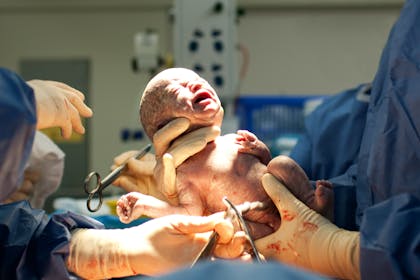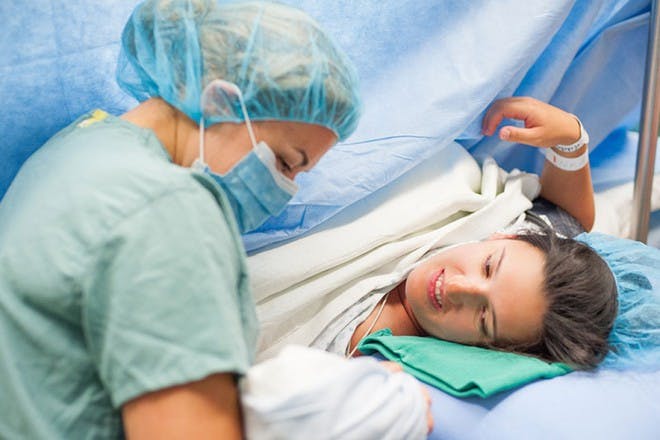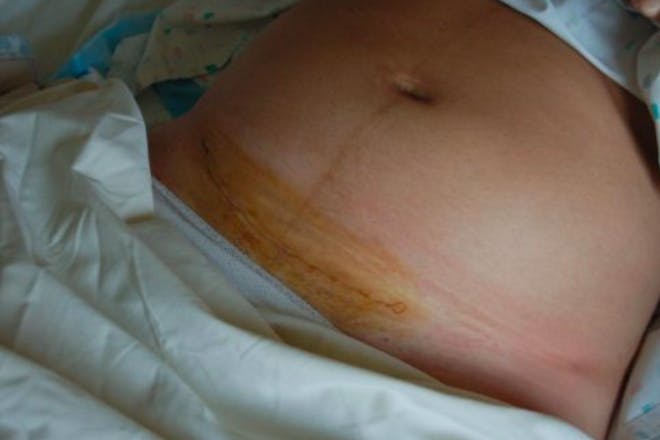We look into the reasons for having a C-section, as well as what to expect before, during and after the procedure. Plus, are you entitled to have a C-section? Read on...
This page contains affiliate links, which means we may earn a small amount of money if a reader clicks through and makes a purchase. All our articles and reviews are written independently by the Netmums editorial team.
What is a C-section?
A C-section – or caesarean section – is an operation to deliver your baby via a cut across your tummy. It takes place at hospital in an operating theatre and is performed by a surgeon, rather than a midwife.
According to the NHS , around one in four pregnant women will give birth this way (as opposed to vaginally) in the UK.
What's the difference between a planned and emergency C-section?
You may have heard of C-sections referred to as planned (elective) or emergency. Here's the difference between them:
FREE NEWBORN NAPPIES
- A planned (elective) C-section – this happens when a decision has been made during your antenatal appointments that this is the best way for you to give birth. Your C-section will be booked in two to three weeks before your due date.
- An emergency C-section – if you've started to have a vaginal birth but the baby gets into distress or the labour isn't progressing, your midwife or doctor may want to get them out quickly by emergency C-section. If you've already had an epidural , this can be topped up to work as your anaesthetic for the operation. They're not all life-or-death 'emergencies' though, and sometimes you'll have a bit of time to make a decision.
If your C-section isn't planned and is emergency, you'll have to give your consent before being wheeled from the labour ward to the operating theatre. Not consenting can put you or your baby's health at risk.
Both involve the same operation as above and are performed by a surgeon.
Should I have a C-section?
As any C-section (planned or emergency) is a major surgical procedure, there are risks attached.
Therefore your midwife will only suggest you have a (planned) C-section if:
- your baby is in a breech position (feet first) or transverse position (lying sideways) and your doctor has been unable to turn them by applying gentle pressure to your tummy, or you would prefer they didn't try this
- you have a low-lying placenta ( placenta praevia )
- you have pregnancy-related high blood pressure ( pre-eclampsia )
- you have certain infections, such as a genital herpes infection occurring for the first time late on in your pregnancy, or untreated HIV
- you've had previous C-sections – if the reasons for these still apply to this pregnancy ie if a vaginal birth is risky for you and your baby, for example.
- your baby has a fetal illness or a congenital condition that might make a natural vaginal birth even more difficult or dangerous.
An unplanned (emergency) C-section may be recommended if:
- your baby isn't getting enough oxygen or nutrients
- your labour isn't progressing
- you bleed a lot during your labour
Can I choose to have a C-section?
Yes, even if you don't fit into any of the above criteria for having a C-section, you can still choose to have one.
Your midwife will talk you through the pros and cons and try to help with any anxieties, if that's what's putting you off having a vaginal birth.
But it is your right to give birth by C-section.
Here's the latest statement on choosing to have a C-section from the Royal College of Obstetricians & Gynaecologists (RCOG):
'The RCOG agrees that caesarean section is a major operation, which in general should be reserved for those mothers or babies who have a medical indication.
'However, in line with NICE guidance in the UK, we also believe that if a woman requests a caesarean section, she should be informed of all the risks and benefits of the procedure and, if appropriate, be given the support of a counsellor or psychologist.
'If she remains certain that caesarean section is the right option for her, then that choice should be fully respected.'
Giving birth by C-section: what happens before?
If you're having a planned C-section you'll be booked into the antenatal day unit for a pre-op appointment a week before your C-section date. This is for you to ask any questions you may have.
You'll also need to:
- have a blood test to check your iron levels
- get medication to take before the procedure – this may include antibiotics, anti-sickness medication (anti-emetics) and medication to reduce the acidity of your stomach acid (antacids)
- discuss anaesthetic options with an anaesthetist – either using a spinal block or an epidural (so you can stay awake) or a general anaesthetic (where you'll be put to sleep - this is much less common)
- sign a consent form for the operation
- be given steroid injections (if you are less than 38 weeks and 6 days) to help with your baby's breathing after delivery
- confirm the date and time for your C-section (and establish when you can eat or drink on that day)
You'll also be given an anti-bacterial wash to use in the days leading up to your C-section. This is to help reduce the risk of infection. (See below for more about these risks.)
Giving birth by C-section: what happens during the procedure?
When it's time to have the procedure you'll get changed into a hospital gown and have a catheter inserted into your bladder to help you wee during the operation. You'll also be put on a drip in your arm.
Then the anaesthetist will set up a spinal block or an epidural . These both work in similar ways; numbing your lower half via an injection in your lower back but enabling you to stay fully awake. They can take up to 20 minutes for the numbing effect to kick in so don't worry, it soon will.
Then the operation can begin. It should take about 45 minutes. Here's what to expect:
- You'll lie down on an operating table that's slightly tilted to help maintain your blood pressure.
- A team of medical staff will come into the operating room. These will include your anaesthetist, surgeon, a nurse and sometimes also a midwife, student doctors (if you consent) and medical assistants.
- A screen or curtain will be pulled across so you can't see what's going on at the point of incision.
- The surgeon will make a horizontal cut just below your belly button tissues, moving tummy muscles and your bladder out of the way to get to your womb. You shouldn't feel anything but you may hear some unnerving suction and splattering noises as this is done.
- Your baby will be lifted out – this can take about 10 minutes or so and some women say they feel a tugging sensation at this point – and then given to you for skin-to-skin contact.
- You'll be given an oxytocin injection to encourage your womb to contract and help with blood loss.
- You'll have your womb cleaned out and closed up and your tummy will be stitched or stapled up. This can take around half an hour.
The whole operation usually takes about 40 to 50 minutes.
Your partner will usually be allowed into the operating theatre but they'll have to wear a hospital gown, hat, face mask and special shoes for hygiene reasons.
Will I feel anything during a c-section?
You won't feel pain during the C-section, although you may feel slightly strange sensations like pulling and pressure.
Most women are awake during the procedure and are simply numbed from the waist down using regional anaesthesia (an epidural and/or a spinal block).
In this instance, you are awake and able to see and hear your baby being born.
Sometimes, although less often, women who need an emergency C-section might require general anaesthesia, which means being unconscious (asleep) during the delivery, in which case you won't remember anything or feel any pain.
Can I have a general anaesthetic?
According to the National Childbirth Trust (NCT), 10% of C-sections are performed using general anaesthetic. This is where you're put to sleep while the baby is removed by C-section.
As there are more health risks linked to having a general anaesthetic, it's usually only used if there's a health risk attached to having a spinal or epidural, and there's no other option.
The main differences when you have a C-section with a general anaesthetic are:
- you'll be asleep and unaware of what's happened until you wake up
- your partner won't be allowed into the operating theatre
- you won't have skin-to-skin contact until you're awake (your partner will be able to while you're asleep)
What are the risks of having a C-section?
Any major operation carries risks with it and a C-section is no exception, so you'll be at increased risk of:
- infection (either around the site of the wound, a uterine infection or a urinary infection)
- developing a blood clot
- damage to other organs in your pelvis and uterus (bladder, bowel or the womb) can occur
- bleeding during or after the operation (which may require further surgery to stop).
Although the risks are low, you'll have an increased chance of complications if:
- you've had previous surgery
- you have a high BMI
- you have existing medical health problems
- you have a history of blood clots.
What happens straight after a C-section?
You'll be wheeled from the operating theatre into the recovery room, where you'll be monitored regularly.
You'll need:
- Painkillers – once the epidural wears off you'll be sore. Paracetamol and ibuprofen are safe to take if you're breastfeeding. If you need something stronger, talk to your GP; codeine (co-codamol) and aspirin aren't usually recommended if you're breastfeeding.
- Help to reduce the risk of blood clots such as compression stockings or injections of blood-thinning medication.
- Food and water – as you won't have eaten for a bit, have some tea and toast as soon as you can
- Help with breastfeeding – you'll be tender, emotional and sore, so make sure you ask for help from the midwife.
Can I breastfeed after a C-section?
There's no reason why you can't breastfeed after a C-section.
Skin-to-skin contact once the baby is born can help with bonding and stimulating your milk. Ask the midwives (and your partner or visitors) for help lifting your baby, as this can make it difficult for post-C-section mums.
Read more about the myths surrounding C-section here.
Recovery from a C-section: how long does it take?
It takes about six weeks for you to recover fully from your operation, so by your six-week check you should be feeling a bit stronger and less sore.
It's important not to overdo it while you're recovering or it can take longer. Many women are advised to avoid driving for several weeks after a C-section, so bear that in mind.
Your scar may still feel sore and uncomfortable for some time, especially if there has been some nerve damage. It should stop being sore after about six months though.
You'll also find that you have an apron of loose, saggy skin. This will shrink down over time as the skin and tissues heal.
You'll still experience vaginal bleeding (lochia) after the birth, so stock up on maternity pads.
Recovery from a C-section: what can I do to help myself?
NHS advice recommends the following to help the recovery rate after your operation:
- Make sure you eat and drink as instructed, both before and after your surgery.
- Try to get up and walk around as early as possible.
- Make sure you take regular pain relief (as this will help with your mobility and general wellbeing).
The NHS advises going straight to your GP or hospital if you have any of the following signs of infection or blood clot after a C-section:
- severe pain
- leaking urine
- pain when peeing
- heavy vaginal bleeding
- your wound becomes more red, painful and swollen
- a discharge of pus or foul-smelling fluid from your wound
- a cough or shortness of breath
- swelling or pain in your lower leg
Your midwife will advise how to look after your wound after your operation, but generally you'll need to:
- keep it clean and dry
- wear loose, comfortable clothes and cotton underwear to avoid irritating it
- take painkillers if the wound is sore
- keep an eye out for signs of infection
Will I have permanent scar?
Yes, although it will fade a lot in the weeks and months after the birth. There's no evidence that using scar creams will have any effect on how your scar looks, but you can try them if you want.
Bio oil is great for scars. See more details here at Boots.
Applying a cream once your wound has fully closed and your stitches have been removed or dissolved may help calm the redness and stop any soreness or irritation, though.
Can I drive after a C-section?
There's no exact guidance on when you can start driving, lifting and exercising again other than it should be when you're fully recovered.
Many women choose to wait until their doctor says it's OK to do so – usually at their six-week check.
It's worth knowing that although you don't need to tell the DVLA if you've had a C-section, you may need to tell your insurance company.
Will I need to have a C-section for future babies?
Not necessarily, although it will depend on the reasons you had a C-section previously as well as how your next pregnancy goes.
Most maternity units will aim for you to have a vaginal birth after caesarean (VBAC) each time unless it poses any danger to either yourself or your baby.
You'll be able to discuss this in detail with your midwife.
Having a C-section: the pros
- Your vagina remains intact – no stitches, tearing or stretching.
- You'll feel no pain during your labour experience.
- You know exactly when you're going to have the baby – no waiting for waters to break.
- You can be more relaxed and plan around your due date – handy if you have other kids and need to sort childcare while you're having the baby.
- You may feel less stressed (if you chose it because you were anxious about having a vaginal birth).
Having a C-section: the cons
- It's a major operation with risks attached.
- Recovery tends to take longer than a vaginal birth.
- Babies born by caesarean are slightly more at risk of asthma and some allergies. This is thought to be due to missing out on beneficial exposure to gastrointestinal bacteria from the mother, which babies are exposed to in vaginal childbirth.
- Some mums find breastfeeding hard to do as you can't lift your baby on your own.
- You'll have a C-section scar.
C-sections in the news
A 2018 study found that women at around 75% of maternity units across the UK are being denied the right to choose a caesarean, despite guidelines urging doctors to give women the choice.
The National Institute for Health and Care Excellence (NICE) advises:
'Pregnant women should be offered evidence-based information and support to enable them to make informed decisions about childbirth.
Addressing women's views and concerns should be recognised as being integral to the decision-making process.'
But figures obtained by the charity Birthrights showed that of the 146 trusts that shared their policies, just 26% fully complied with guidelines and 15% refused all elective caesareans.
Birthrights' policy recommends that trusts should take a 'a woman-centred approach'.
The report added that 'pregnant women in some regions who ask about the procedure are simply told to go elsewhere'.
In reaction to the report, chief executive of Birthrights, Rebecca Schiller said:
'Maternal request caesareans are the the number one reason women contact the Birthrights advice service.
'The women we support have endured previously traumatic births, physical ill-health, childhood sexual abuse or have carefully examined the evidence available and made informed decisions that planned caesareans will give them and their baby the best chance of an emotionally and physically healthy start.'
What to Expect When You're Expecting by Heidi Murkoff is a must-read book for all expectant parents. See more details here at Amazon.
You can also buy it here at Waterstones.
Are you booked in for a caesarean? Or have you had one in childbirth before? Share your experiences over on our forum:









